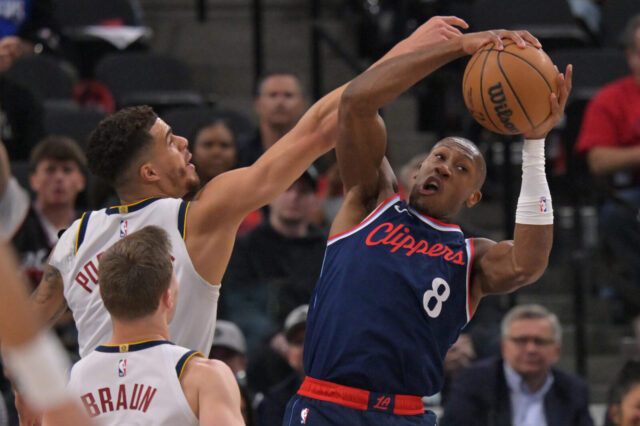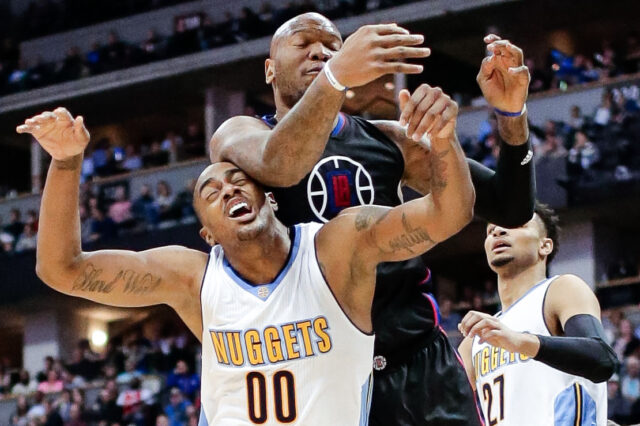When the Denver Nuggets acquired Jerami Grant, I was secretly disappointed. Not because Grant was a bad player, since I happen to think Grant is excellent, but because for the second straight season, the Nuggets had traded away their first round pick. The Nuggets have been constructed almost entirely through the draft and residual trades, with a key exception being the signing of Paul Millsap in 2017 free agency. President of Basketball Operations Tim Connelly and the rest of the Nuggets staff have proven to have a keen eye for draft prospects, knowing exactly when and how to take a chance. The Nuggets have drafted all four of Nikola Jokic, Gary Harris, Jamal Murray, and Michael Porter Jr. in the last six seasons.
It appeared that the Nuggets wouldn’t have another first round pick until 2021, but in early February, the Nuggets sent Malik Beasley, Juancho Hernangomez, and Jarred Vanderbilt (all draftees) to the Minnesota Timberwolves, receiving the Houston Rockets 2020 first round pick in a four-team deal. With Beasley and Juancho immediately showcasing their talent in extended minutes with a bad T’Wolves team, there has been pressure on the Nuggets to make the most of that draft pick. Whether it be used as an actual selection or flipped to acquire a player capable of helping Denver win a championship, Nuggets fans are antsy for results.
If I were Connelly and Co. I would get greedy and try to draft another player capable of changing the organization.
For the next several weeks on every Thursday, Denver Stiffs writers will be putting together a combination of individual player profiles, lists, big boards, mock drafts, and other NBA Draft related content to help Nuggets fans become familiar with the 2020 draft class. With the class being fairly light on high end talent, players could have wide ranges based on team needs, and a player the Nuggets may think is a top 5 player in the class could spiral out of the lottery fairly quickly. That means Nuggets fans have to be prepared for every scenario, meaning we at Denver Stiffs are getting an early start on draft content.
The first player to receive an individual profile? Local CU standout power forward Tyler Bey.
Tyler Bey – University of Colorado
Vitals
Age: 22 (born February 10, 1998)
Height: 6-foot-7
Weight: 216 pounds
Wingspan: 7-foot
Per game Stats (Junior season)
| Minutes | Points | Rebounds | Assists | Steals | Blocks | 2-point % | 3-point % | Free Throw % |
|---|---|---|---|---|---|---|---|---|
| 29.0 | 13.8 | 9.0 | 1.5 | 1.5 | 1.2 | 54.5% | 41.9% | 74.3% |
Strengths
Athleticism and Physical Tools
When watching Tyler Bey play basketball, the first thing that stands out is how agile he is for his size. At 6-foot-7 and 216 pounds, he moves quicker than the players his size at the college level, and there are very few players at his size that also play power forward. Bey sprints the length of the floor in long, easy strides, making him a major threat in transition.
Nikola Jokic is always looking for the outlet pass in transition, and Bey is more than willing to run the deep route. His athleticism helps him get to the basketball on outlets and alley-oops, and his wingspan helps him corral almost every pass.
Rebounding
Bey averaged 9.0 rebounds per game during his junior season, but his more impressive campaign rebounding was his sophomore year, in which he grabbed 9.9 rebounds in just 26.3 minutes per contest. That ranked eighth in the entire NCAA in 2018-19 and first in the PAC-12 Conference. At his size, rebounding numbers like those are fairly impressive, showcasing just how NBA ready his athleticism and instincts are.
Defensive Tools
Having both high steal and block rates at the NCAA level is very impressive, as it isn’t common for players to be as versatile, physical, and smart enough on the defensive end as Bey was this year. Only two other players in college basketball could say they matched Bey’s 48 steals and 36 blocks on the shortened season, and neither of the other two guys played in a high level program.
Often, Bey was tasked with guarding the opposing team’s best wing scorer. It didn’t matter that Bey was truly a power forward and projects to be so at the next level, but he truly has great physical tools to be one of the elite forward defenders at the next level. Great footwork and fundamentals shadowing a ball handler, length to contest every shot and block shots at the rim, and a good motor to finish the play until he or someone else grabs a rebound. He often switched onto guards and could stay in front of them, and he battled with centers and larger power forwards when he was in that position.
Bey was awarded the PAC-12 Defensive Player of the Year for his work this year, and it further encapsulates what level of defender he could be at the next level. Some other recipients of the DPOY award in the PAC-12 the past few years: Matisse Thybulle, Jordan Bell, Gary Payton II, Andre Roberson, and Russell Westbrook. High level athletes with good instincts and physicality when they set their minds to it.
Offensive Touch
Lost in the potential for a great defensive prospect is his touch both around the rim and on his jump shot. He can be inconsistent, but the fluidity from his athleticism also translates to his movements around the basket. He has some great finishes that aren’t just dunks, and his willingness to pop for a midrange jumper shows some confidence, including the makings of a perimeter jumper.
It certainly helped that Bey could dunk as often as he did, but his 61.1 True Shooting % is relatively rare for a forward that takes some jumpers like this:
In today’s NBA, it takes a very special circumstance for a player to NOT have to learn how to make threes to be a valuable piece. Bey would have to develop this portion of his game in order to make the most of his NBA career, but he has a good foundation now.
Role Player Potential
With his ability to play off-ball offensively, set screens, rebound, and defend, Bey projects to be a plug-and-play rookie with enough versatility and wherewithal to make a positive impact. Much like Brandon Clarke on the Memphis Grizzlies, the best thing for Bey would be to give him a simple role as a finisher on offense and switchable defender that can use his tools to be impactful. He doesn’t have to be the creator of the offense, nor does he have to rely on an elite jumper to make things work. It’s hard to NOT make an impact in today’s NBA when you stand at 6-foot-7 with elite athleticism. He will find a place in a rotation for sure.
Weaknesses
Offensive Polish
While the role player potential stands out, any team looking to draft Bey for his star upside will probably be disappointed. The lack of offensive polish manifests itself in several ways, but primarily, Bey struggles making moves as a post player with his back to the basket when he doesn’t face up. He has a solid hook shot, but his only counter is a delayed up-and-under.
Passing Instincts
In addition, Bey is generally on the receiving end of passes but doesn’t have a great feel for passing to others. There are times where he receives the ball in the paint and should be kicking out rather than forcing up a tough jumper. He averaged 1.5 assists compared to 2.4 turnovers per game, struggling to deal with double teams and reading the court in difficult situations.
Sometimes, elite vertical athletes struggle making the right pass because they frequently jump over everyone. At the NBA level though, Bey will be surrounded by elite athletes capable of blocking his shot at any time. Reading the floor is extremely important in Denver’s offense, and it’s one of the keys to staying on the floor in a playoff series.
Perimeter Shooting
Over 80% of Bey’s field goal attempts came inside the paint and below the dotted semi-circle. Other than the occasional jump shot to keep defenses honest, Bey’s offensive role was waiting to receive the ball in and around the paint area. In the NBA, that won’t be the case. He will be asked to primarily stand on the perimeter if he’s not involved in the main action.
In an offense featuring Jamal Murray, Michael Porter Jr., and Nikola Jokic going forward, the Nuggets need players who can both space the floor and attack the rim. Bey can certainly attack the rim, but it remains to be seen if he will figure it out as a shooter. His career college free throw percentage of 74.7% is a decent indicator for his growth, and some of the midrange jumpers he attempts will be pushed out to long range.
He shows the capability, and he did shoot over 40% from three this season. The problem was the attempts, and it’s hard to tell how real that jumper can be. Still, the mechanics are decent when he’s pushed like on the clip above. Giving him time in an NBA development program could help turn an inconsistent jumper into a strength.
Age
This is a simple one. Bey is already 22 as a junior and will turn 23 next February. He likely doesn’t have too many hidden skills beyond what he has shown. Could he become a ball handler and develop some true passing instincts? It’s highly unlikely that he will be anything other than a finisher and defender at the next level.
Verdict
Tyler Bey is exactly the kind of player that makes sense at power forward next to Michael Porter Jr. and Nikola Jokic. High level athlete, doesn’t need the ball to be impactful, elite defensive potential with capability to defend different kinds of players, and a developing jumper. With Porter being as big as he is, it may make sense for him to defend power forwards and for whoever plays power forward to defend small forwards. Jerami Grant projects as that kind of defender. Bey does too.
Often, high level defensive players are drafted lower than the high level offensive players. Of the 10 players to make an All-Defensive team last year, only three (Joel Embiid, Marcus Smart, and Paul George) were drafted in the top 10 selections. Rudy Gobert was 27th overall. Kawhi Leonard and Giannis Antetokounmpo were each 15th overall. Draymond Green was 35th overall. Tyler Bey fits the profile as well. Unpolished offensive player that spent three seasons in college but had success defensively as an elite athlete with good instincts.
If the Nuggets keep their pick from the Houston Rockets, they must use it wisely. With so many questions at power forward and center this offseason, adding Tyler Bey will be something the Nuggets seriously consider. The need for versatility and high level athleticism at the highest levels of competition has become apparent for Denver, and adding Bey to the rotation would give the Nuggets a serious boost in that regard.


